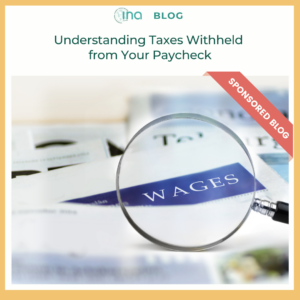
By HomeWork Solutions
Introduction:
Taxes are an integral part of our society, funding crucial government programs and services that benefit us all. In this blog, we will delve into the different categories of taxes that are typically withheld from a worker’s paycheck, providing you with an understanding of how they are used. To illustrate these concepts, we’ll use an example with an annual wage of $55,000 for a single individual with no dependents.
Social Security and Medicare Taxes:
Social Security and Medicare taxes, often referred to as FICA taxes, are withheld to fund social security benefits and healthcare services for retirees and certain individuals with disabilities. For 2023, the Social Security tax rate is 6.2% on wages up to $142,800, and the Medicare tax rate is 1.45% on all wages. Since our example worker’s annual wage does not exceed the Social Security taxable limit, the annual Social Security tax withheld would be $3,410 (6.2% of $55,000). Additionally, the annual Medicare tax withheld would amount to $797.50 (1.45% of $55,000).
Federal Income Tax (FIT):
One of the primary taxes withheld from your paycheck is the federal income tax. It is a progressive tax, meaning the amount you owe increases as your income rises. The federal income tax is used to fund various federal programs, including national defense, education, infrastructure (roads, libraries, emergency services, etc.), healthcare, and support programs for veterans and those in need. The amount withheld is determined based on your income and the information you provide on your Form W-4. For our example with an annual wage of $55,000, the annual federal tax withheld would amount to about $4,718.
State Income Tax (SIT):
In addition to federal taxes, many states also impose an income tax. The specific tax rates and rules vary by state. What these taxes fund also varies. Generally speaking, these taxes fund things such as education, healthcare, and infrastructure. For the sake of this example, let’s assume our worker resides in a state with a 5% flat income tax rate. In this case, the annual state tax withheld would be $2,750 (5% of $55,000).
Other Withholdings:
Apart from the aforementioned taxes, your paycheck may also have other withholdings which are mandatory at the state or local level for things like local income(LIT), paid family leave(PFL/PFML) or transit. It may also have deductions specific to you, such as contributions to retirement plans, and other voluntary deductions. These vary depending on your individual circumstances and the benefits offered by your employer. It’s important to review your pay stub to understand all the deductions made from your paycheck and ensure their accuracy.
Conclusion:
Understanding the taxes withheld from your paycheck makes it easier to manage your finances. It also helps you to understand where those tax dollars go, and the programs and services they fund. Some services you likely use every day, and others you will likely want to use in the future. To evaluate your specific tax obligations, remember to consult with a tax professional or use trusted online resources. Tax obligations may change over time, so stay up to date with the latest tax laws and regulations applicable to your geographic location, and specific situation.

